Search Result
Results for "
lactic acid
" in MedChemExpress (MCE) Product Catalog:
1
Biochemical Assay Reagents
13
Isotope-Labeled Compounds
| Cat. No. |
Product Name |
Target |
Research Areas |
Chemical Structure |
-
- HY-B2227
-
Lactate
3 Publications Verification
lactic acid
|
Endogenous Metabolite
|
Metabolic Disease
Inflammation/Immunology
Cancer
|
|
Lactate (Lactic acid) is a hydroxycarboxylic acid receptor 1 (HCAR1) activator and an epigenetic modulator inducing lysine residues lactylation. Lactate is a glycolysis end-product, bridging the gap between glycolysis and oxidative phosphorylation. Lactate is an oncometabolite and has immune protective role of lactate in anti-tumor immunity .
|
-
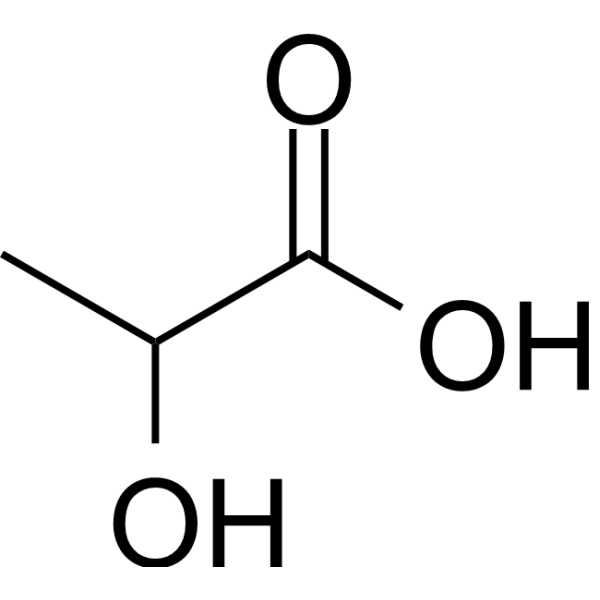
-
- HY-B2227B
-
|
lactic acid sodium
|
Others
|
Metabolic Disease
|
|
Lactate (Lactic acid) sodium is the product of glycogenolysis and glycolysis . Lactate (Lactic acid) sodium is an organic salt that is mainly used as a buffer and pH adjuster for injection solutions. Lactate sodium can be metabolized by the body into sodium bicarbonate, which in turn acts to increase the pH of the blood. Lactate sodium is used to improve metabolic acidosis and hypovolemic states. In terms of pharmaceutical preparations, Lactate sodium is often used in combination with sodium chloride, glucose, etc. to form normal saline or compound liquid intravenous injection . Lactate sodium also has antimicrobial activity, which can be used as a food preservative .
|
-

-
- HY-B2227BS2
-
|
lactic acid-13C sodium
|
Isotope-Labeled Compounds
|
Metabolic Disease
|
|
Lactate- 13C (sodium) is the 13C labeled Lactate sodium[1]. Lactate (Lactic acid) sodium is the product of glycogenolysis and glycolysis. Lactate (Lactic acid) sodium functions in a variety of biochemical processes[2].
|
-
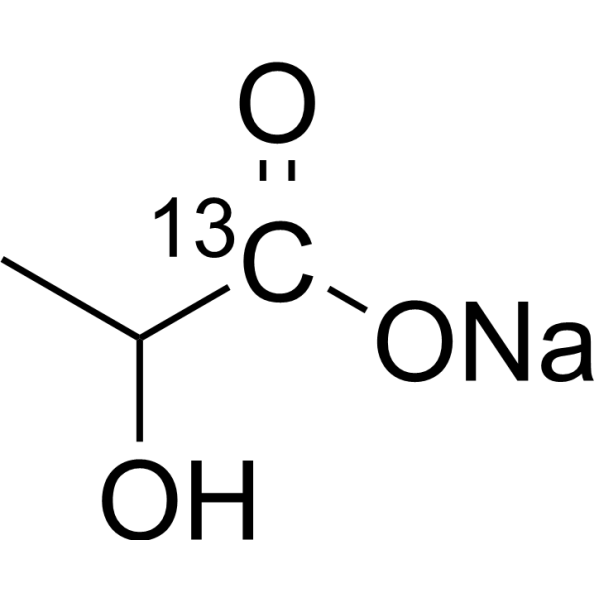
-
- HY-B2227A
-
|
lactic acid calcium
|
Bacterial
|
Cancer
|
|
Lactate (Lactic acid) calcium is used by the beverage industry as a source of calcium to fortify fruit juice. Lactate calcium facilitates the growth and phytic acid degradation of soybean sprouts .
|
-
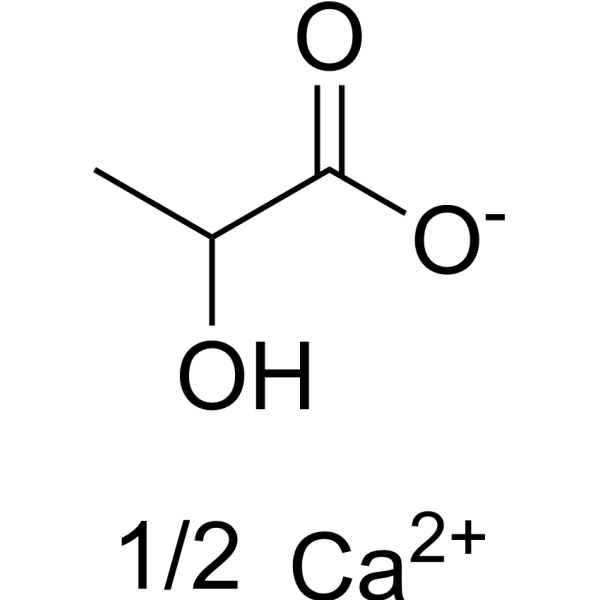
-
- HY-B2227C
-
|
lactic acid potassium
|
Bacterial
|
Infection
Others
|
|
Lactate (Lactic acid) potassium is used as a sodium chloride substitute in the elaboration of dry meat products. Lactate potassium (56%) and sodium diacetate (4%) mixture inhibit the development of L. sake and L. monocytogenes bacteria at 4℃ to extend the shelf life of food .
|
-

-
- HY-B2227BS3
-
|
lactic acid-13C-1 sodium
|
Isotope-Labeled Compounds
|
Metabolic Disease
|
|
Lactate- 13C-1 (sodium) is the 13C labeled Lactate (sodium)[1]. Lactate (Lactic acid) sodium is the product of glycogenolysis and glycolysis. Lactate (Lactic acid) sodium functions in a variety of biochemical processes[2].
|
-

-
- HY-B2227BS
-
|
lactic acid-d4 sodium
|
Isotope-Labeled Compounds
|
Others
|
|
Lactate-d4 (sodium) is the deuterium labeled Lactate sodium. Lactate sodium is the product of glycogenolysis and glycolysis. Lactate sodium functions in a variety of biochemical processes[1][2].
|
-

-
- HY-B2227BS1
-
|
lactic acid-d3 sodium
|
Isotope-Labeled Compounds
|
Others
|
|
Lactate-d3 (sodium) is the deuterium labeled Lactate sodium. Lactate sodium is the product of glycogenolysis and glycolysis. Lactate sodium functions in a variety of biochemical processes[1][2].
|
-
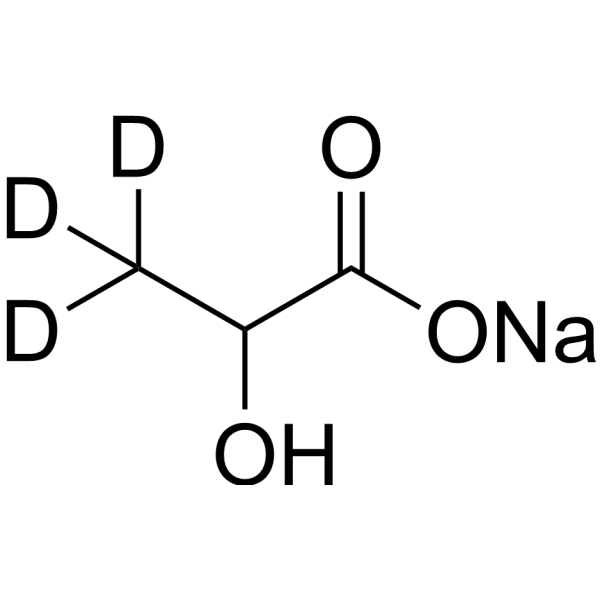
-
- HY-141540
-
|
|
Others
|
Others
|
|
Lactyl-CoA is an acyl-CoA formally condensed from the sulfhydryl group of CoA and the carboxyl group of lactic acid, also known as lactyl-CoA. Lactyl-CoA is essential for the biosynthesis of biodegradable and biocompatible lactic acid-based copolymers .
|
-
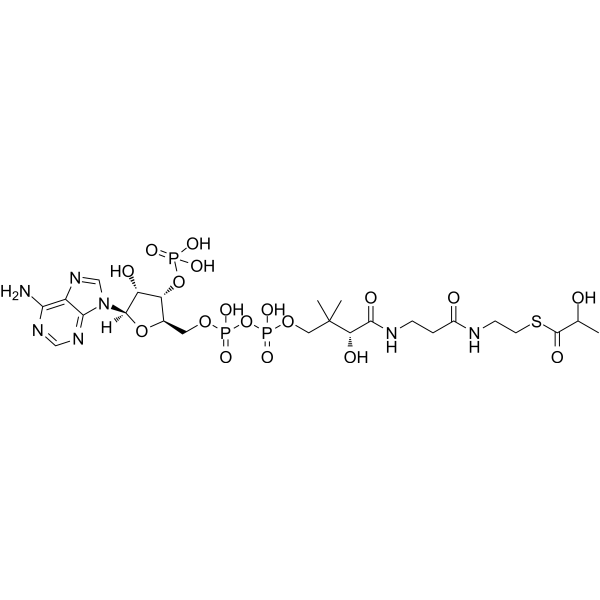
-
- HY-Y0479
-
|
(S)-2-Hydroxypropanoic acid
|
|
|
|
L-Lactic acid is a buildiing block which can be used as a precursor for the production of the bioplastic polymer poly-lactic acid.
|
-
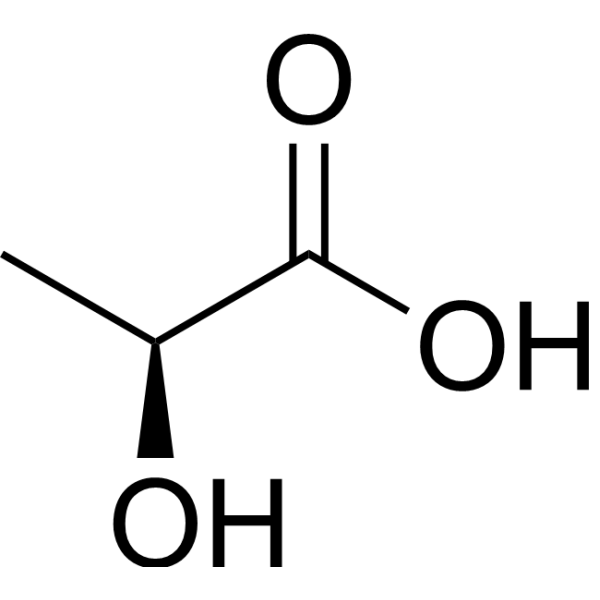
-
- HY-Y0479S3
-
-
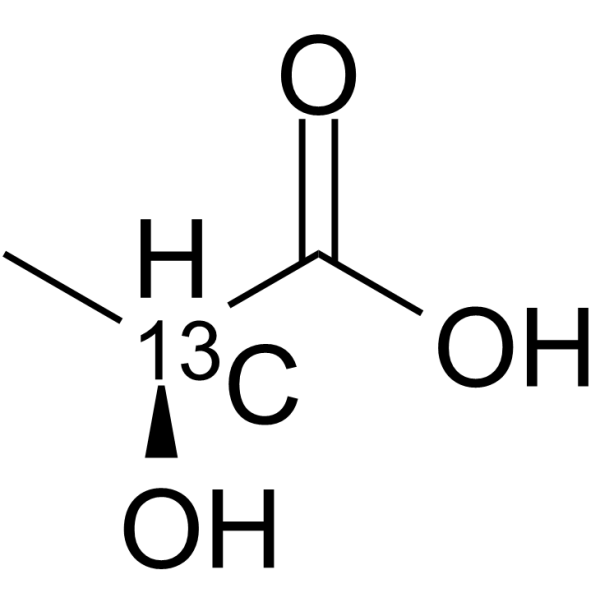
-
- HY-113099
-
|
Indole-3-lactic acid
|
Endogenous Metabolite
|
Inflammation/Immunology
|
|
Indolelactic acid (Indole-3-lactic acid) is a tryptophan (Trp) catabolite in Azotobacter vinelandii cultures. Indolelactic acid has anti-inflammation and potential anti-viral activity .
|
-
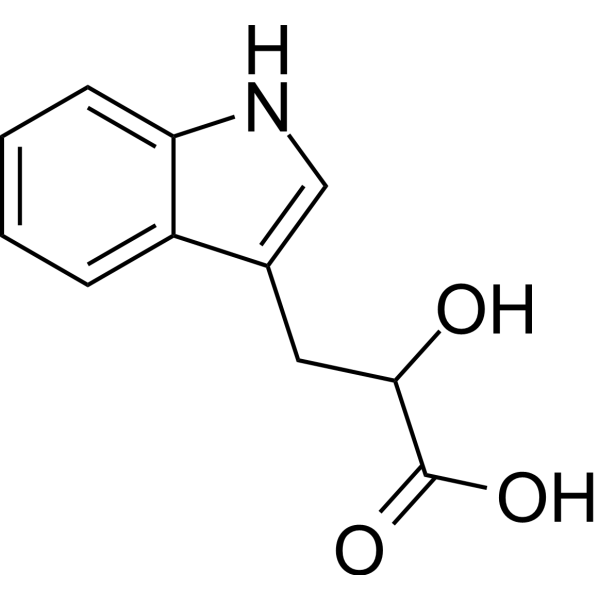
-
- HY-111095S2
-
|
(R)-2-Hydroxypropionic acid-13C-1; D-lactic acid-13C-1
|
Endogenous Metabolite
|
Others
|
|
D-(-)-Lactic acid- 13C-1 is the 13C labeled D-(-)-Lactic acid. D-(-)-Lactic acid is a normal intermediate in the fermentation (oxidation, metabolism) of sugar. D-(-)-Lactic acid is identified to be a competitive inhibitor of ProDH (proline dehydrogenase) in plants .
|
-
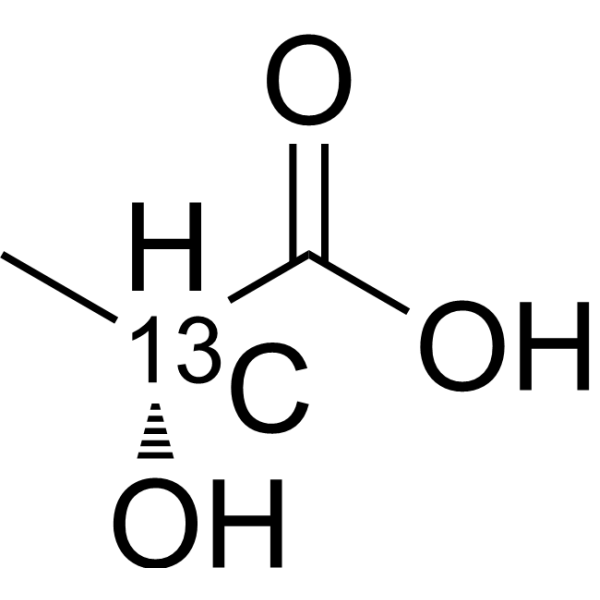
-
- HY-10058
-
|
|
JAK
Aurora Kinase
Bcr-Abl
FLT3
Apoptosis
Autophagy
|
Cancer
|
|
AT9283 lactic acid is a multi-targeted kinase inhibitor with potent activity against Aurora A/B, JAK2/3, Abl (T315I) and Flt3 (IC50s ranging from 1 to 30 nM). AT9283 lactic acid inhibits growth and survival of multiple solid tumors in vitro and in vivo .
|
-
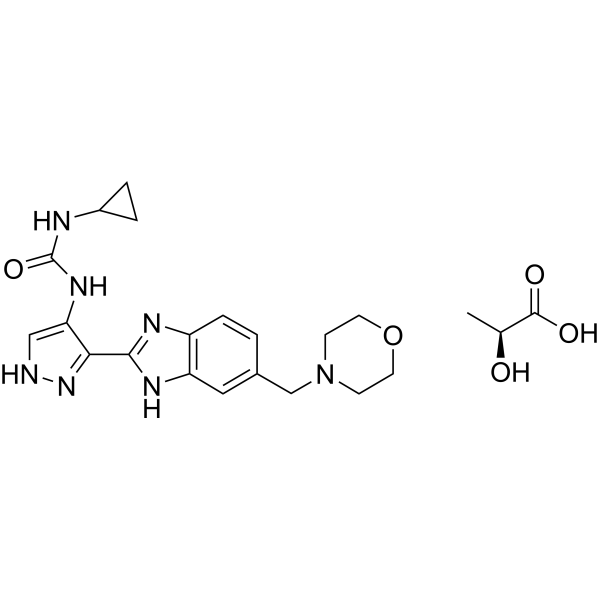
-
- HY-111095B
-
-

-
- HY-141941S
-
-
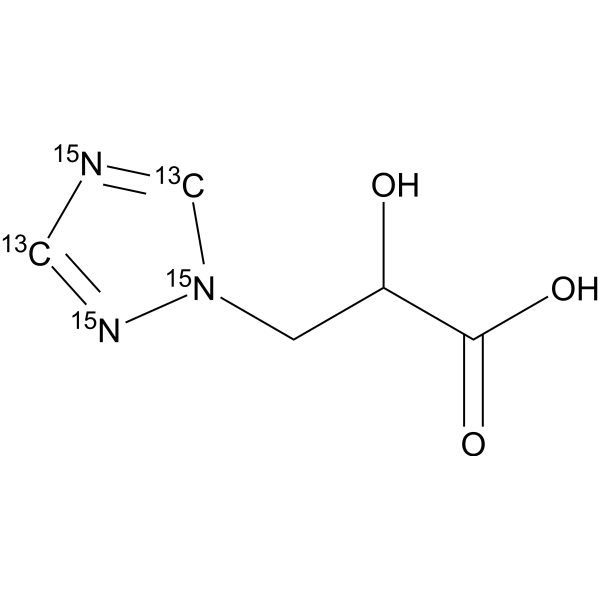
-
- HY-111095S1
-
|
(R)-2-Hydroxypropionic acid-13C; D-lactic acid-13C
|
Isotope-Labeled Compounds
|
Others
|
|
D-(-)-Lactic acid-13C ((R)-2-Hydroxypropionic acid-13C) is a 13C-labeled D-Lactic acid. D-(-)-Lactic acid-13C can be used as an internal standard and can also be used in studies such as metabolic tracing.
|
-

-
- HY-Y0479S
-
-
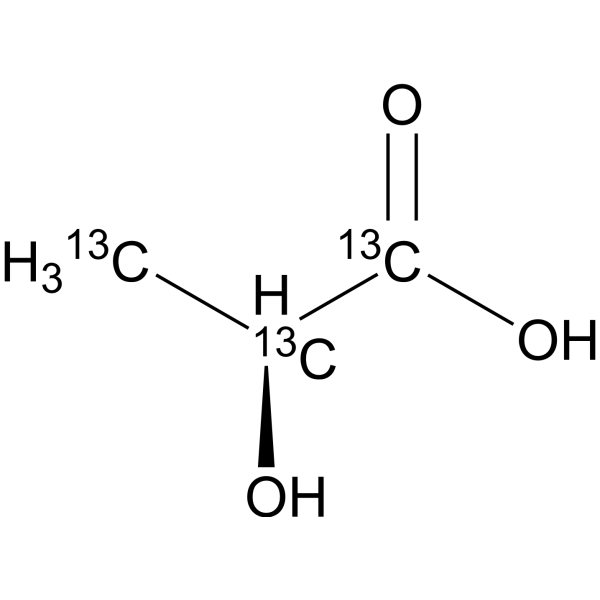
-
- HY-111095S3A
-
|
(R)-2-Hydroxypropionic acid-13C-2 sodium; D-lactic acid-13C-2 sodium
|
Isotope-Labeled Compounds
|
Others
|
|
D-(-)-Lactic acid-13C-2 (sodium) is a sodium. D-(-)-Lactic acid-13C-2 (sodium) can be used for a variety of biochemical studies.
|
-
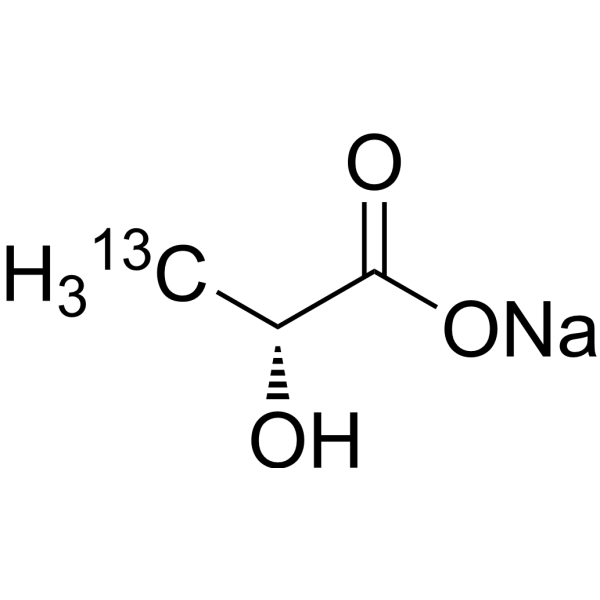
-
- HY-D0884
-
|
(S)-2-Hydroxypropanoic acid lithium
|
|
|
|
L-Lactic acid (lithium) is a chemical compound belonging to the class of lithium salts. It is commonly used in the pharmaceutical industry as a mood stabilizer and antipsychotic for the improvement of bipolar disorder and schizophrenia. L-Lactic acid (lithium) works by affecting the balance of certain chemicals in the brain, which can help reduce symptoms such as mood swings, aggression, and hallucinations.
|
-
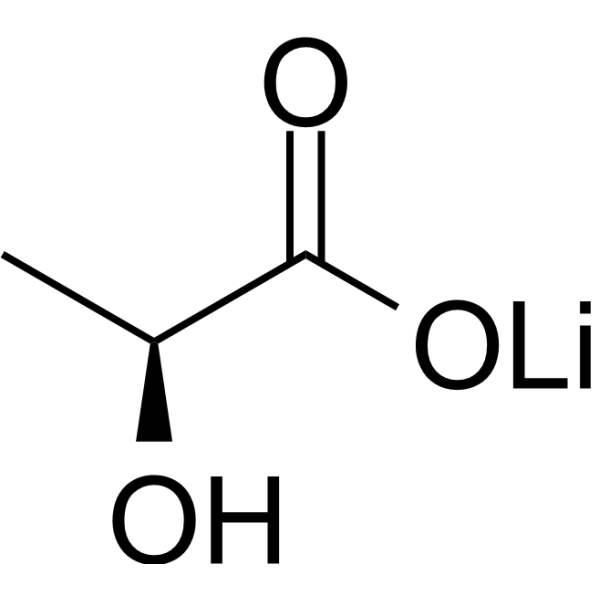
-
- HY-Y0479AS
-
-

-
- HY-B2247
-
|
poly(lactic-co-glycolic acid) (50:50)
|
Biochemical Assay Reagents
|
Others
|
|
PLGA (50:50) (poly(lactic-co-glycolic acid) (50:50)) is a copolymer of poly lactic acid (PLA) and poly glycolic acid (PGA) which can be used to fabricate devices for drug delivery and tissue engineering applications.
|
-
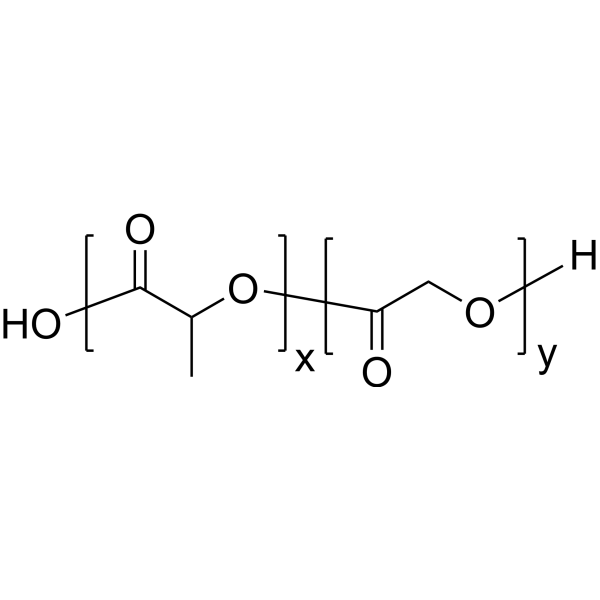
-
- HY-N9274
-
|
|
Others
|
Others
|
|
3-Hydroxy-3-(4-hydroxyphenyl)-lactic acid is a key metabolite in the P. roqueforti fermentation approach, with quantitative data of 10.2 ± 1.1 µM in Tyr 1 (presence of L-tyrosine) of .
|
-
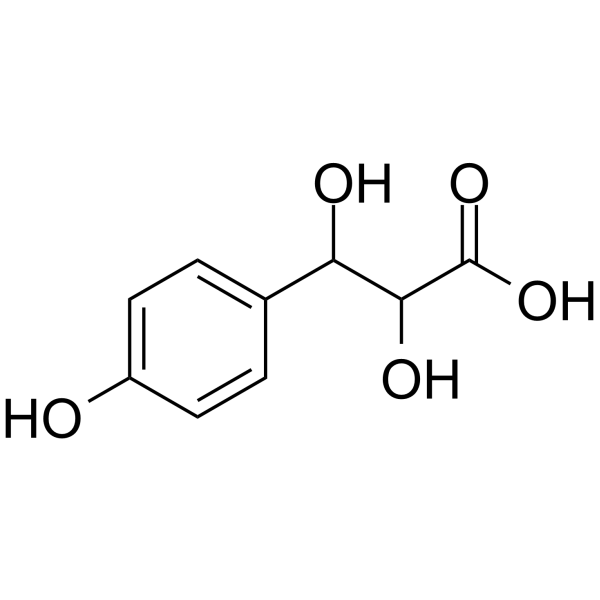
-
- HY-107727
-
|
|
Neuropeptide Y Receptor
|
Neurological Disease
|
|
BMS-193885 (L-Lactic acid) is a potent, selective, and brain-penetrant neuropeptide Y1 receptor antagonist. BMS-193885 has a Ki value of 3.3 nM for the neuropeptide Y1 receptor, competitively acts on the neuropeptide Y binding site, and can reduce food intake and body weight through central Y1 inhibition .
|
-
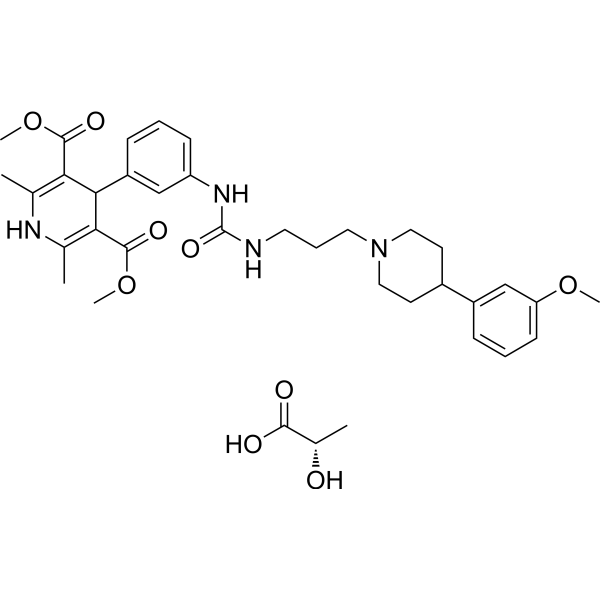
-
- HY-Y0445A
-
|
|
PDHK
Reactive Oxygen Species
NKCC
Apoptosis
|
Cancer
|
|
Sodium dichloroacetate is a metabolic regulator in cancer cells' mitochondria with anticancer activity. Sodium dichloroacetate inhibits PDHK, resulting in decreased lactic acid in the tumor microenvironment. Sodium dichloroacetate increases reactive oxygen species (ROS) generation and promotes cancer cell apoptosis. Sodium dichloroacetate also works as NKCC inhibitor .
|
-

-
- HY-N8139
-
|
|
Others
|
Metabolic Disease
|
|
2-Amino-3-carboxy-1,4-naphthoquinone is the electron transfer mediator. 2-Amino-3-carboxy-1,4-naphthoquinone changes glucose metabolism of the homofermentative lactic acid bacteria .
|
-
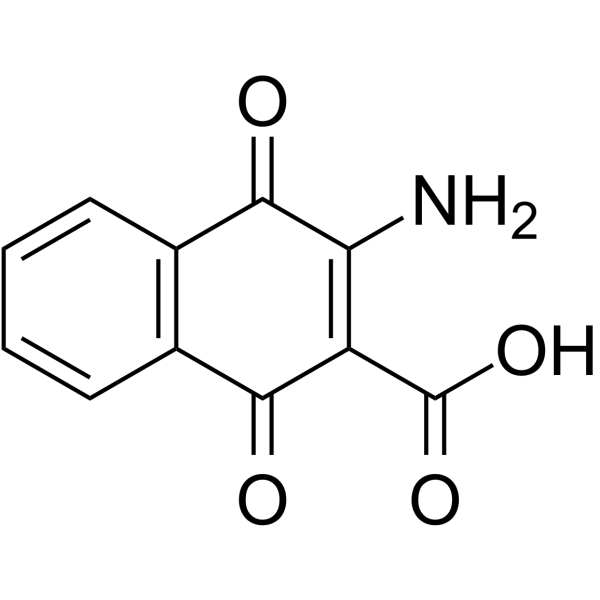
-
- HY-113133
-
|
|
Glucosidase
|
Infection
Metabolic Disease
Inflammation/Immunology
|
|
Kojibiose, an orally active prebiotic disaccharide, can specifically inhibit the activity of α-glucosidase I. kojibiose is a proliferation factor for Bifidobacterium, lactic acid bacteria, and eubacteria. kojibiose is a low-calorie sweetener capable of increasing the absorption of iron. Kojibiose exhibits antitoxic activity. Kojibiose reduces hepatic expression of inflammatory markers in vivo .
|
-

-
- HY-B2247A
-
|
poly(lactic-co-glycolic acid) (75:25)
|
Biochemical Assay Reagents
|
Others
|
|
PLGA (75:25) is a low toxicity, biocompatible and biodegradable controlled drug delivery carrier, can achieve slow release in the organism. PLGA (75:25) is a copolymer of 75% poly lactic acid (PLA) and 25% poly glycolic acid (PGA). PLGA (75:25) has been extensively studied as delivery vehicles for agents, proteins and various other macromolecules such as DNA, RNA and peptides .
|
-

-
- HY-B1530
-
|
(±)-Ammonium lactate
|
|
|
|
Ammonium lactate is the ammonium salt of lactic acid, with mild anti-bacterial properties. Ammonium lactate can be used for the research of xerosis .
|
-

-
- HY-W040233
-
|
Sodium L-lactate
|
Others
|
Others
|
|
Sodium (S)-2-hydroxypropanoate (Sodium L-lactate) is a buildiing block which can be used as a precursor for the production of the bioplastic polymer poly-lactic acid .
|
-
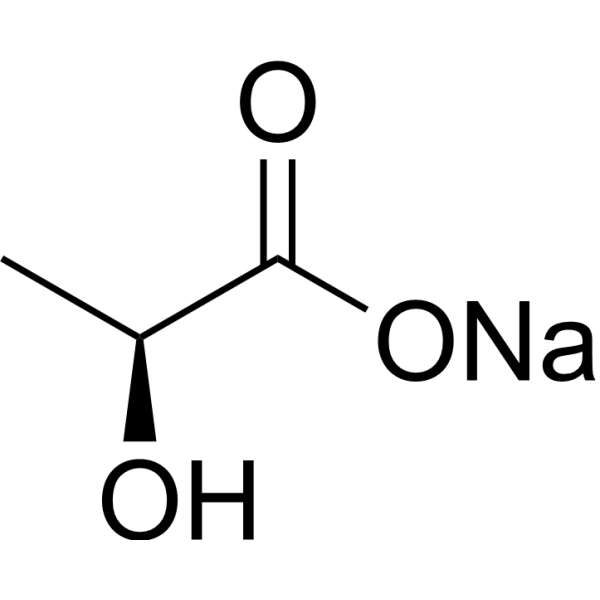
-
- HY-W040233B
-
|
Sodium L-lactate (purity≥90%)
|
Others
|
Others
|
|
Sodium (S)-2-hydroxypropanoate (Sodium L-lactate) (purity≥90%) is a buildiing block which can be used as a precursor for the production of the bioplastic polymer poly-lactic acid .
|
-
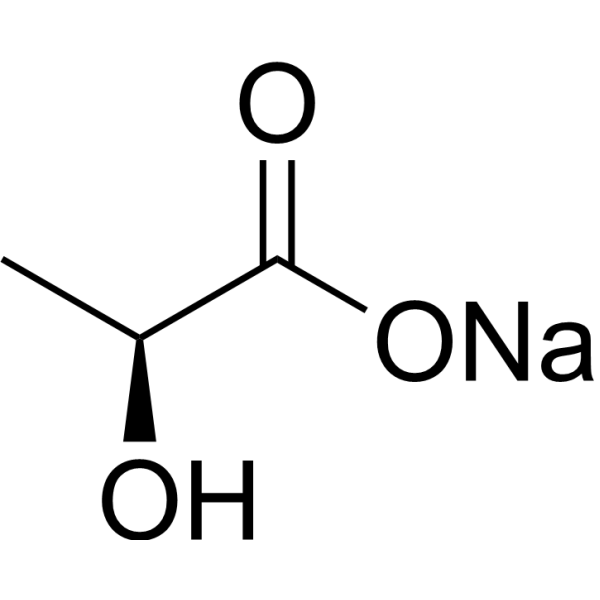
-
- HY-136593
-
|
(S)-3-(4-Hydroxyphenyl)lactic acid
|
Others
|
Others
|
|
(S)-3-(4-Hydroxyphenyl)-2-hydroxypropionic acid (compound 1) is a metabolite isolated from the culture medium of Leuconostoc mesenteroides. (S)-3-(4-Hydroxyphenyl)-2-hydroxypropionic acid has high DPPH radical-scavenging activities and antioxidative activities .
|
-

-
- HY-130117
-
|
|
Reactive Oxygen Species
Apoptosis
|
Cancer
|
|
AlbA-DCA is a conjugate formed by the attachment of Albiziabioside A (AlbA) to a dichloroacetate acid (DCA) subunit. AlbA-DCA can induce a marked increase in intracellular ROS and alleviate the accumulation of lactic acid in tumor microenvironment (TME), and also selectively kills cancer cells and induce apoptosis .
|
-
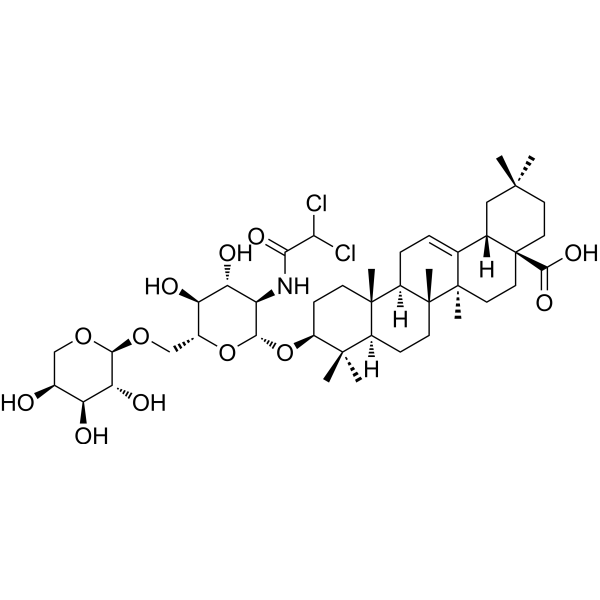
-
- HY-113099S
-
|
Indole-3-lactic acid-d5
|
Endogenous Metabolite
|
Others
|
|
Indolelactic acid-d5 is the deuterium labeled Indolelactic acid. Indolelactic acid is a tryptophan (Trp) catabolite in Azotobacter vinelandii cultures.
|
-
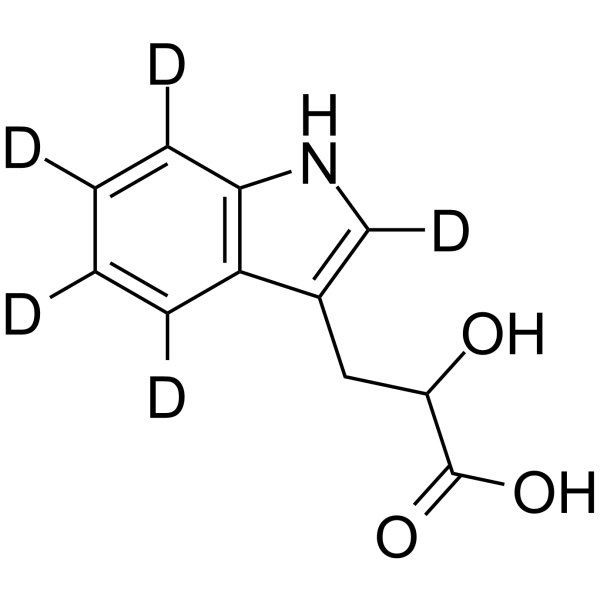
-
- HY-W005288
-
|
|
Apoptosis
Endogenous Metabolite
|
Cancer
|
|
4-Vinylphenol is found in the medicinal herb Hedyotis diffusa Willd, wild rice and is also the metabolite of p-coumaric and ferulic acid by lactic acid bacteria in wine. 4-Vinylphenol induces apoptosis and inhibits blood vessels formation and suppresses invasive breast tumor growth in vivo .
|
-

-
- HY-W002299
-
|
Boc-D-Leu-OH hydrate
|
Amino Acid Derivatives
|
Neurological Disease
|
|
Boc-D-Leucine monohydrate (Boc-D-Leu-OH hydrate) is an N-Boc-protected form of D-Leucine (L330150). D-Leucine is an unnatural isomer of L-Leucine (L330110) that acts as an auto-inhibitor of lactic streptococci. D-Leucine shows potent anti-seizure effect .
|
-
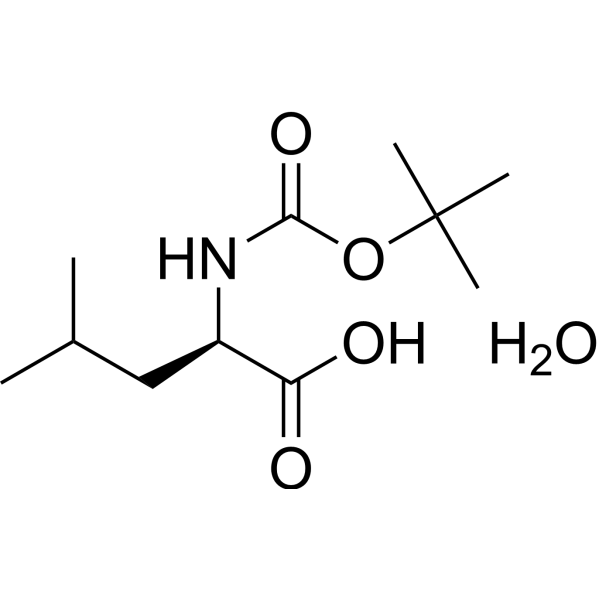
-
- HY-16397
-
|
Phenethylbiguanide
|
Mitochondrial Metabolism
AMPK
Apoptosis
|
Metabolic Disease
Cancer
|
|
Phenformin (1-phenethylbiguanide) is an orally active antidiabetic and anticancer agent. Phenformin has an incidence of associated lactic acidosis. Phenformin acts through acting AMPK activation and blocking mTOR pathway. Phenformin is also a substrate of P-glycoprotein (P-gp), and an OXPHOS inhibitor. Phenformin induces cancer cell apoptosis .
|
-
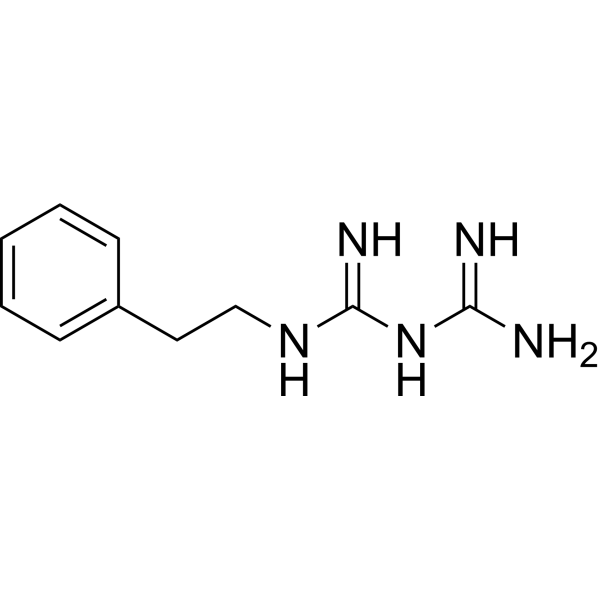
-
- HY-Y0335
-
|
Dihydroxyacetone
|
|
|
|
1,3-Dihydroxyacetone (DHA), the main active ingredient in sunless tanning skin-care preparations and an important precursor for the synthesis of various fine chemicals, is produced on an industrial scale by microbial fermentation of glycerol (HY-B1659) in Gluconobacter oxydans. 1,3-Dihydroxyacetone is also used for synthesis of new biodegradable polymers by combining with lactic acid (HY-B2227) .
|
-
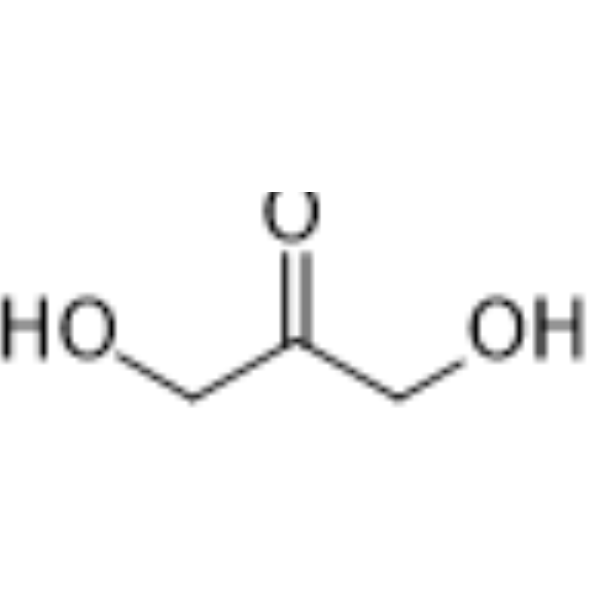
-
- HY-D0153
-
|
|
Fluorescent Dye
|
Cancer
|
|
Tetramethylrhodamine-5-isothiocyanate is a potent fluorescent dye. Tetramethylrhodamine-5-isothiocyanate can be used for label PG-M3 antibody for rapid diagnosis of acute promyelocytic leukemia (APL). Tetramethylrhodamine-5-isothiocyanate can be used as probe to quantify in vivo the biodistribution of PLGA (poly(lactic-co-glycolic) acid) and PLGA/chitosan nanoparticles .
|
-

-
- HY-129101
-
|
Eseroline fumarate
|
5-HT Receptor
|
Neurological Disease
|
|
(-)-Eseroline fumarate is a metabolic of Physostigmine (HY-N6608), an AChE inhibitor. (-)-Eseroline fumarate elicits a leakage of lactic acid dehydrogenase (LDH) from cancer cells. (-)-Eseroline fumarate also induces the release of adenine nucleotides and 5-hydroxytryptamine (5-HT) from neuronal cells, thus induce cell death. (-)-Eseroline fumarate inhibits the electrically evoked twitches of the mouse vas deferens and of the guinea-pig ileum .
|
-

-
- HY-156829
-
|
|
Others
|
Cancer
|
|
PLGA-PEG-PLGA (1500-1500-1500) (LA/GA 1:1) is a matrix materia, with lactic acid (LA):glycolic acid (GA) = 1:1, that acts as anti-cancer drug delivery. PLGA-PEG-PLGA (1500-1500-1500) (LA/GA 1:1) can improve a drug's bioavailability, efficacy, water solubility, drug encapsulation efficiency, sustained drug release, and to minimize undesirable toxicity .
|
-

-
- HY-156829A
-
|
|
Others
|
Cancer
|
|
PLGA-PEG-PLGA (1500-1500-1500) (LA/GA 15:1) is a matrix materia, with lactic acid (LA):glycolic acid (GA) = 15:1, that acts as anti-cancer drug delivery. PLGA-PEG-PLGA (1500-1500-1500) (LA/GA 15:1) can improve a drug's bioavailability, efficacy, water solubility, drug encapsulation efficiency, sustained drug release, and to minimize undesirable toxicity .
|
-
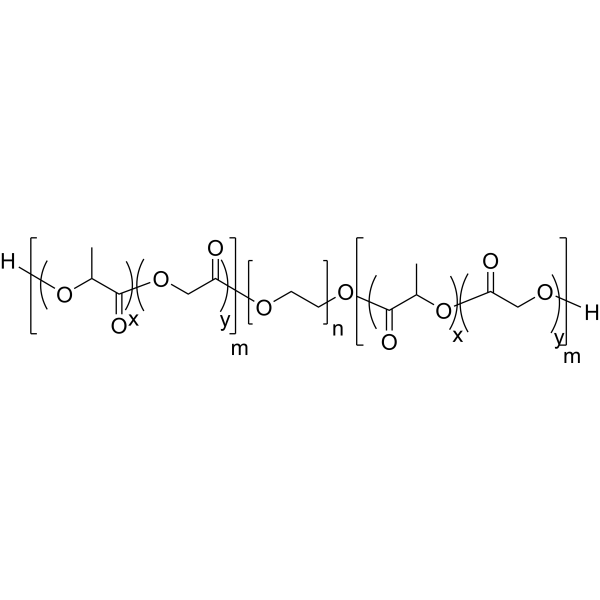
-
- HY-W127505S
-
|
|
Biochemical Assay Reagents
Isotope-Labeled Compounds
|
Others
|
|
trans-2-Undecenal-d5 is deuterated labeled 4-Vinylphenol (HY-W005288). 4-Vinylphenol is found in the medicinal herb Hedyotis diffusa Willd, wild rice and is also the metabolite of p-coumaric and ferulic acid by lactic acid bacteria in wine. 4-Vinylphenol induces apoptosis and inhibits blood vessels formation and suppresses invasive breast tumor growth in vivo .
|
-
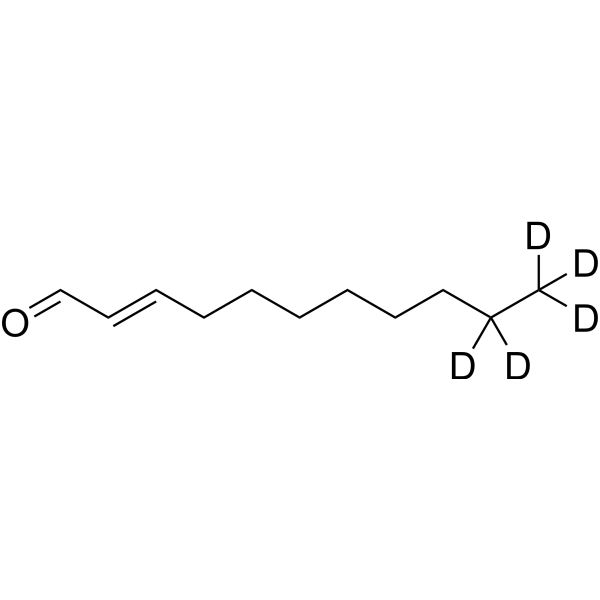
-
- HY-148775
-
|
|
Biochemical Assay Reagents
|
Others
|
|
PLGA-PEG-MAL (60kDA-3.4kDA, LA:GA ratio 75:25) is a kind of poly(lactide-co-glycolide)-block-poly(ethylene glycol) (PLGA-PEG-Mal) nanoparticles. PLGA-PEG-MAL (60kDA-3.4kDA, LA:GA ratio 75:25) has a molecular weight of 60kDA to 3.4kDA and contains a 75:25 ratio of lactic acid (LA) to glycolic acid (GA) molecules .
|
-

-
- HY-148775B
-
|
|
Biochemical Assay Reagents
|
Others
|
|
PLGA-PEG-MAL (20kDA-5.0kDA, LA:GA ratio 40:60) is a kind of poly(lactide-co-glycolide)-block-poly(ethylene glycol) (PLGA-PEG-Mal) nanoparticles. PLGA-PEG-MAL (20kDA-5.0kDA, LA:GA ratio 40:60) has a molecular weight of 60kDA to 3.4kDA and contains a 75:25 ratio of lactic acid (LA) to glycolic acid (GA) molecules .
|
-
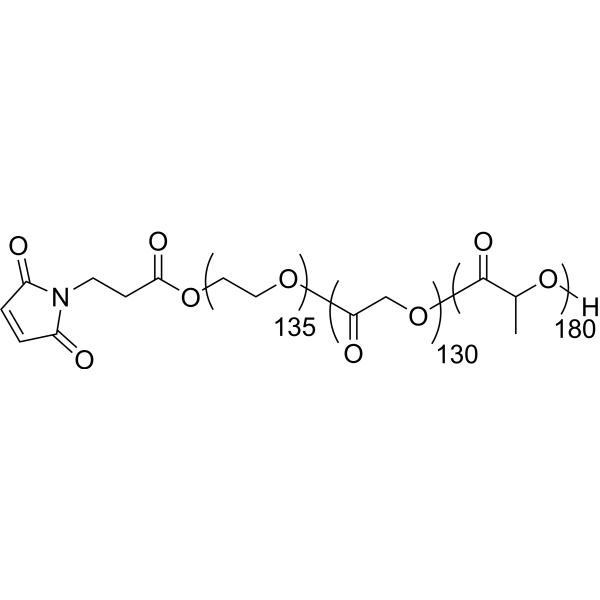
-
- HY-148776
-
|
|
Biochemical Assay Reagents
|
Others
|
|
PLGA-PEG-MAL (20kDA-5.0kDA, LA:GA ratio 50:50) is a kind of poly(lactide-co-glycolide)-block-poly(ethylene glycol) (PLGA-PEG-Mal) nanoparticles. PLGA-PEG-MAL (20kDA-5.0kDA, LA:GA ratio 50:50) has a molecular weight of 20kDA to 5.0kDA and contains a 50:50 ratio of lactic acid (LA) to glycolic acid (GA) molecules. The molecular ratio of LA to GA determines the rate of matrix degradation and protein re-release .
|
-
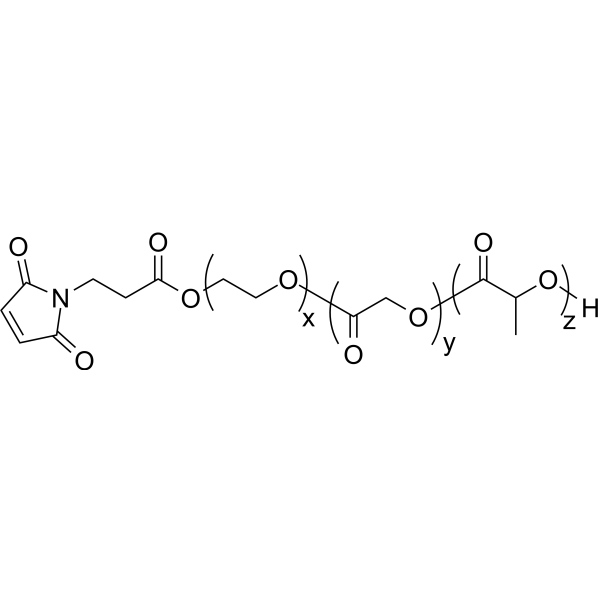
| Cat. No. |
Product Name |
Type |
-
- HY-D0153
-
|
|
Fluorescent Dyes/Probes
|
|
Tetramethylrhodamine-5-isothiocyanate is a potent fluorescent dye. Tetramethylrhodamine-5-isothiocyanate can be used for label PG-M3 antibody for rapid diagnosis of acute promyelocytic leukemia (APL). Tetramethylrhodamine-5-isothiocyanate can be used as probe to quantify in vivo the biodistribution of PLGA (poly(lactic-co-glycolic) acid) and PLGA/chitosan nanoparticles .
|
| Cat. No. |
Product Name |
Type |
-
- HY-B2247
-
|
poly(lactic-co-glycolic acid) (50:50)
|
Drug Delivery
|
|
PLGA (50:50) (poly(lactic-co-glycolic acid) (50:50)) is a copolymer of poly lactic acid (PLA) and poly glycolic acid (PGA) which can be used to fabricate devices for drug delivery and tissue engineering applications.
|
| Cat. No. |
Product Name |
Target |
Research Area |
-
- HY-P4519
-
|
|
Peptides
|
Others
|
|
Ac-Lys(Ac)-D-Ala-D-Lactic acid is a depsipeptide substrate for penicillin-sensitive D-alanine carboxypeptidases (DD-carboxypeptidases) .
|
-
- HY-P4837
-
|
|
Peptides
|
Others
|
|
Ac-Lys-D-Ala-D-lactic acid is a polypeptide that can be found by peptide screening. Peptide screening is a research tool that pools active peptides primarily by immunoassay. Peptide screening can be used for protein interaction, functional analysis, epitope screening, especially in the field of agent research and development .
|
-
- HY-W002299
-
|
Boc-D-Leu-OH hydrate
|
Amino Acid Derivatives
|
Neurological Disease
|
|
Boc-D-Leucine monohydrate (Boc-D-Leu-OH hydrate) is an N-Boc-protected form of D-Leucine (L330150). D-Leucine is an unnatural isomer of L-Leucine (L330110) that acts as an auto-inhibitor of lactic streptococci. D-Leucine shows potent anti-seizure effect .
|
| Cat. No. |
Product Name |
Category |
Target |
Chemical Structure |
| Cat. No. |
Product Name |
Chemical Structure |
-
- HY-B2227BS2
-
|
|
|
Lactate- 13C (sodium) is the 13C labeled Lactate sodium[1]. Lactate (Lactic acid) sodium is the product of glycogenolysis and glycolysis. Lactate (Lactic acid) sodium functions in a variety of biochemical processes[2].
|
-

-
- HY-B2227BS
-
|
|
|
Lactate-d4 (sodium) is the deuterium labeled Lactate sodium. Lactate sodium is the product of glycogenolysis and glycolysis. Lactate sodium functions in a variety of biochemical processes[1][2].
|
-

-
- HY-B2227BS1
-
|
|
|
Lactate-d3 (sodium) is the deuterium labeled Lactate sodium. Lactate sodium is the product of glycogenolysis and glycolysis. Lactate sodium functions in a variety of biochemical processes[1][2].
|
-

-
- HY-B2227BS3
-
|
|
|
Lactate- 13C-1 (sodium) is the 13C labeled Lactate (sodium)[1]. Lactate (Lactic acid) sodium is the product of glycogenolysis and glycolysis. Lactate (Lactic acid) sodium functions in a variety of biochemical processes[2].
|
-

-
- HY-Y0479S3
-
|
|
|
L-Lactic acid-2- 13C1 is the 13C-labeled L-Lactic acid. L-Lactic acid is a buildiing block which can be used as a precursor for the production of the bioplastic polymer poly-lactic acid.
|
-

-
- HY-111095S2
-
|
|
|
D-(-)-Lactic acid- 13C-1 is the 13C labeled D-(-)-Lactic acid. D-(-)-Lactic acid is a normal intermediate in the fermentation (oxidation, metabolism) of sugar. D-(-)-Lactic acid is identified to be a competitive inhibitor of ProDH (proline dehydrogenase) in plants .
|
-

-
- HY-141941S
-
|
|
|
Triazole Lactic Acid- 13C2, 15N3 is the 13C and 15N labeled Triazole Lactic Acid[1].
|
-

-
- HY-111095S1
-
|
|
|
D-(-)-Lactic acid-13C ((R)-2-Hydroxypropionic acid-13C) is a 13C-labeled D-Lactic acid. D-(-)-Lactic acid-13C can be used as an internal standard and can also be used in studies such as metabolic tracing.
|
-

-
- HY-Y0479S
-
|
|
|
L-Lactic acid- 13C3 is a stable isotope labeled L-Lactic acid analog. L-Lactic acid- 13C3 can be used for lactate metabolism research[1].
|
-

-
- HY-111095S3A
-
|
|
|
D-(-)-Lactic acid-13C-2 (sodium) is a sodium. D-(-)-Lactic acid-13C-2 (sodium) can be used for a variety of biochemical studies.
|
-

-
- HY-Y0479AS
-
|
|
|
L-Lactic acid- 13C3 (sodium) is the 13C labeled L-Lactic acid. L-Lactic acid- 13C3 sodium can be used for lactate metabolism research[1].
|
-

-
- HY-113099S
-
|
|
|
Indolelactic acid-d5 is the deuterium labeled Indolelactic acid. Indolelactic acid is a tryptophan (Trp) catabolite in Azotobacter vinelandii cultures.
|
-

-
- HY-W127505S
-
|
|
|
trans-2-Undecenal-d5 is deuterated labeled 4-Vinylphenol (HY-W005288). 4-Vinylphenol is found in the medicinal herb Hedyotis diffusa Willd, wild rice and is also the metabolite of p-coumaric and ferulic acid by lactic acid bacteria in wine. 4-Vinylphenol induces apoptosis and inhibits blood vessels formation and suppresses invasive breast tumor growth in vivo .
|
-

Your information is safe with us. * Required Fields.
Inquiry Information
- Product Name:
- Cat. No.:
- Quantity:
- MCE Japan Authorized Agent:






















































